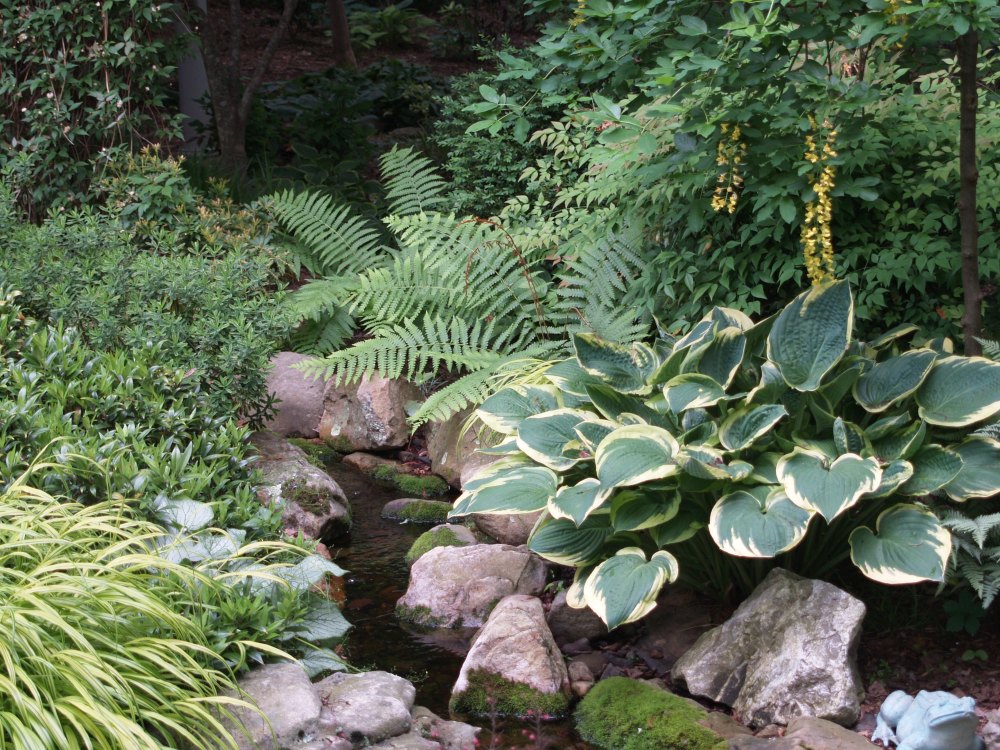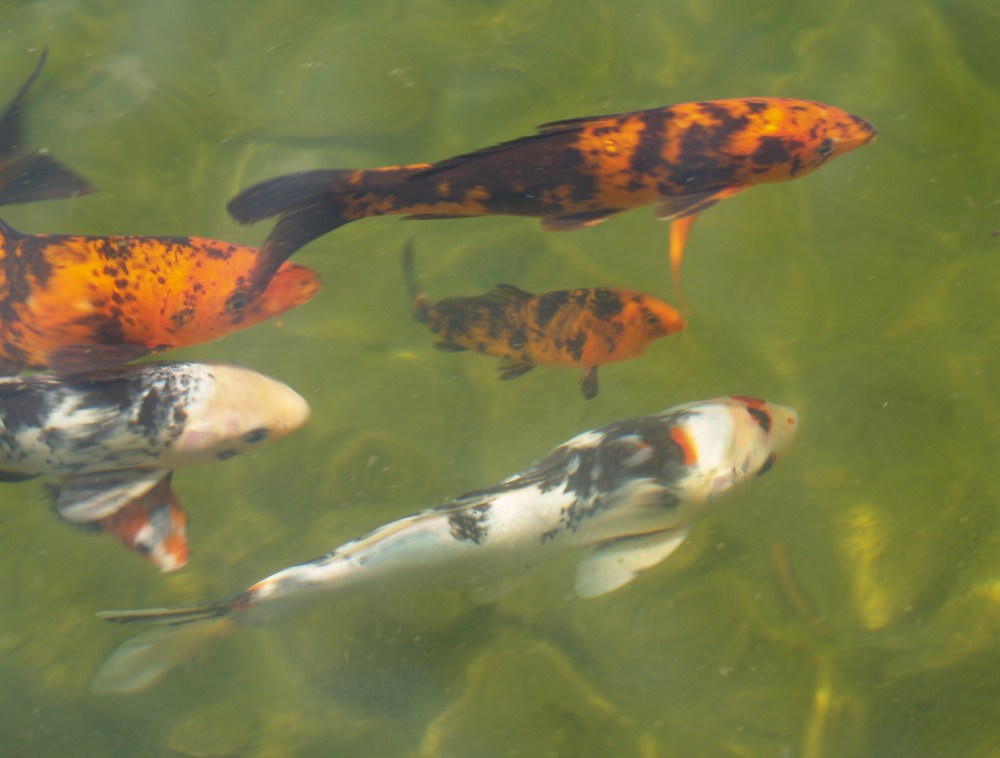The pump went out in one of the garden ponds in late autumn, and I haven’t a clue why. Perhaps it was old age. I know the feeling.
Replacing the pump was a rare expense for my ponds, that is if the cost of running electricity twenty four hours a day for five ponds through the year isn’t considered. I rarely mention this cost, and don’t even think about it when the monthly bill arrives. After more than twenty years living with ponds, I can hardly imagine living without.
Today the ponds aren’t at their best, just water and rocks, moss, and perennial plants that have newly been cut back. The hostas, caryopteris, and hydrageas that flop over to soften the pond’s edges have just broken dormancy, and it will be another month before they make any show at all. The koi and goldfish are barely awake, and only moving about because air and water temperatures are far above normal in the very early days of spring. But, spring peepers and other frogs that return to the ponds to mate are in full throat through the afternoon and evenings.
Three of the five ponds in the garden are under two hundred square feet, one is slightly larger, and the largest pond is bigger than all the others put together. The swimming pond is almost fifteen hundred square feet, and five and a half feet at it deepest point. I should say that it’s a bit of a misnomer to call it a swimming pond, since I don’t really swim in it. Swimming is too much like exercise. I float. I have a reclining lounge chair (with a drink holder in case I’m so inclined) that drifts with the breeze while I slip in and out of consciousness on sunny weekends watching the dragonflies dart overhead with koi nipping at my toes.
Spring clean up of the ponds is a straightforward matter. The swimming pond requires only to drag the net off without dumping too many leaves that have accumulated over the winter. The stirring up of debris leaves the water murky for a few days afterward, but then it clears up and if the water temperature is sufficiently warm the fish suddenly recall that I’m the guy who occasionally feeds them. The whole mess of them flock to whichever side I’m working, and if I’m cutting the Japanese irises that grow in the shallows the large koi will nudge out of the water to remind me that it’s feeding time. Not yet, I’m afraid. In a few more weeks the water will warm up and feeding will begin.
This large pond contains about twenty thousand gallons of water, so I’m determined never to empty it for cleaning. The net keeps the worst of the leaves out, and the few leaves and bits of debris that sink to the bottom break down and disappear without any assistance on my part. On occasion there will be an outbreak of string algae, but barley straw keeps it under control.
I don’t take as much care to cover the smaller ponds, so it’s not unusual for them to require a bit more spring cleanup. Most years I scoop out the leaves, clean the filter pads on the ponds that have them, and the pond is ready to go. If leaves and gunk are too much then the water will be pumped out and discarded into the garden, the leaves and debris scooped out, and the rocks and gravel will be washed down with a hose. Then, the pond is refilled. A dechlorinator is added to condition the water for the fish, frogs, and tadpoles, and the ponds are ready for spring.
The Japanese irises, sweetflag, waterlilies, and other pond plants are treated like any other perennials. The spent growth from last year is pruned off and sent to the compost pile, and they’re ready to go. Most of my pond plants are planted directly in rock and gravel rather than in pots, so there’s no need to divide them or to repot into larger containers. I have never fertlized any of the pond plants and they grow vigorously without.
I drag the nets off the ponds early in March, but don’t usually mess with cleaning the ponds until later in the month. The clean up takes most of a day, though I’m frequently distracted so bits and pieces of other projects take up some of the day. Once the spring cleaning is accomplished there’s very little maintenance done to any of the ponds for the remainder of the year, until the nets go back on in early November. The ponds are the easiest and most enjoyable part of the garden, so replacing a pump every seven or eight years is only a minor nuisance.
I envy you having many ponds! Mine is very small, and has a small leak—–somewhere! This is my first year of over-wintering, so this should be interesting,to say the least! Hopefully,the leak-problem will won’t be too challenging! Wish me luck ! It’s a great ‘site’ you have! Very enjoyable! Thanks!
To find a pond leaf you have to figure whether the leak is in the liner or in the plumbing. Turn off the pump, if there is one, and check the water level after a day or two. If the water level remains constant then the leak is in the plumbing, or in a waterfall or stream that rises when the pump is running. If the water level drops when the pump is off the leak is in the liner. Let the water drop until it stops, and this is the level where the hole is in the liner. Most liner holes can be successfully patched, but most pond leaks are in the moving water, not holes in the liner. Good luck with the leak.
Though my wife would like us to have a small pond or two, she must not be aware of the maintenance required. We probably wouldn’t even have fish in them, just bubbling water. The big trees, however, in our back yard, would probably keep dumping far too many leaves in our ponds, even though I see you use nets from November onward. Just too much of a challange at this time. I’ll settle for the two birdbaths and the one large (4 ft diameter) fountain that keeps the birds and mosquitoes happy, and keeps me active on periodic cleanouts. Really enjoy all your posts, and appreciate the thoughtful assistance you’ve given us when we’ve asked about a garden or lawn problem.
My property borders a wooded area, and I’ve planted thirty or forty additional trees over the years so that I have millions, maybe billions of leaves to contend with. One of the first rules of pond building that I read was to avoid constructing them near trees. I’m pleased that I ignored that one. The leaves are only a minor nuisance, and only in the autumn when the leaves drop.
I share your enjoyment of having ponds. We have 2 joined by a small waterfall. The only problem is using a net over the larger for the fall and winter. It is 15 X 20 feet, so the net needs support. How do you support the net over your large pond. Not finding suitable support, we just remove the leaves continuously – ugh! I’d love to find a solution to this. Any ideas?
Love your column – look forward to each one!
Before the net goes on I crisscross cables across the swimming pond. The net still sags into the water in spots, so the leaves are soggy and heavy when it’s time for the nets to be pulled off. But, the leaves haven’t begun to decay in the cold water, so they don’t foul the water. The main reason for the cables is to keep the nets high enough to leave space for the fish. Rather than using cables, I’ve seen some smaller ponds that arch PVC pipes over the water. By doing this many of the leaves blow off the net, so it probably works better for most ponds.
Thank you for your ideas – we like the idea of arching the PVC pipes. We are ready to try something. We had tried a frame of large PVC and that was too cumbersome for us to handle with wet leaves on it. This idea sounds like it might be a lot easier to handle. We’ll give it a try.